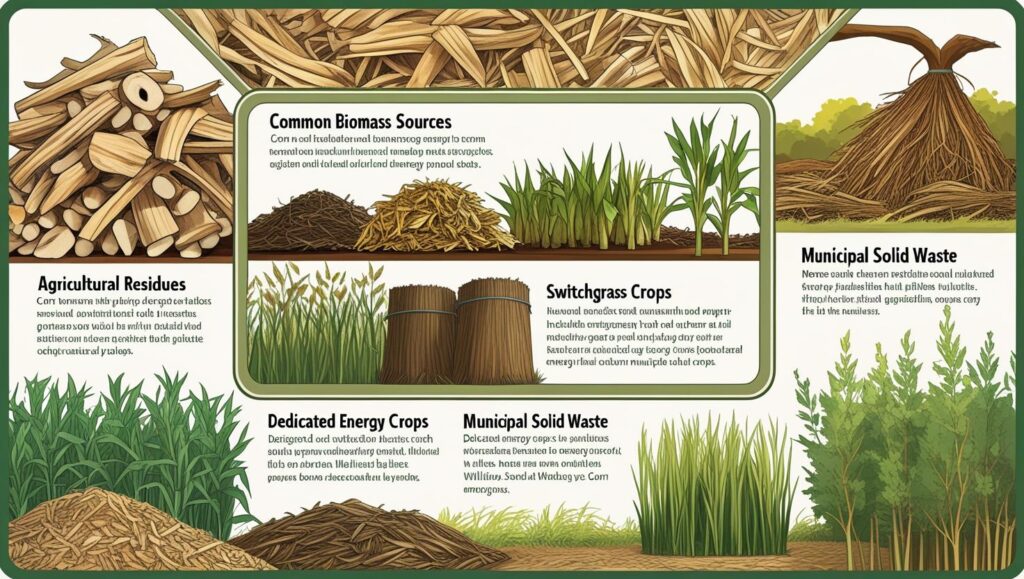In the global push towards a sustainable energy future, renewable resources are taking center stage. While solar, wind, and hydropower often capture the headlines, there’s another powerful player in the mix: biomass. Biomass energy, derived from organic matter, offers a unique and versatile solution for reducing our reliance on fossil fuels. But what exactly is biomass, and where does it come from? The answer is surprisingly diverse. From the leftover stalks in a cornfield to the wood chips from a lumber mill, the variety of **common biomass sources** is vast and growing. This detailed guide will take you on a journey through the most significant types of biomass used for power generation, explaining their origins, their benefits, and their role in creating a cleaner, greener world.
What is Biomass and How is it Converted to Energy?
Biomass is any organic material that can be converted into energy. This includes plants, agricultural waste, and animal waste. The energy stored within these materials originally came from the sun, captured through photosynthesis. When biomass is burned or processed, this stored chemical energy is released as heat, which can then be used to generate electricity or produce heat for industrial and residential use. The process of converting biomass to energy is not a single one; it involves a range of technologies, each suited to different types of biomass feedstock.
The Main Conversion Pathways
- Direct Combustion: The most straightforward method. Biomass is burned in a boiler to produce steam, which then drives a turbine connected to an electric generator. This is similar to how a fossil fuel power plant works, but with a renewable fuel source.
- Gasification: Biomass is heated in a low-oxygen environment to produce a gas called syngas. This syngas can be burned in a boiler or used to power gas turbines and internal combustion engines.
- Anaerobic Digestion: Microorganisms break down organic matter in an oxygen-free environment. This process produces biogas, a methane-rich gas that can be used for electricity generation, heating, or as a vehicle fuel.
The Major Players: Exploring Common Biomass Sources
The beauty of biomass is its diversity. The fuel can come from a wide array of sources, many of which are waste products that would otherwise go unused. This makes it an efficient and circular-economy friendly energy source. Let’s explore some of the most prevalent types of biomass feedstock.
1. Agricultural Residues and Crops
Agriculture produces a massive amount of organic waste, much of which can be repurposed for energy. Instead of being left to rot or burned in open fields, these residues can be a valuable resource. Dedicated energy crops are also grown specifically for the purpose of producing biomass fuel.
Common Agricultural Sources:
This category includes a wide range of materials that are readily available in farming communities worldwide. They represent a significant opportunity for sustainable energy production.
- Corn Stover: The stalks, leaves, and cobs left in the field after corn is harvested.
- Sugarcane Bagasse: The dry fibrous residue that remains after sugarcane stalks are crushed to extract juice.
- Rice Husks: The outer coverings of rice grains, which are a byproduct of milling.
- Energy Crops: Fast-growing plants like switchgrass, miscanthus, and short-rotation woody crops like willow and poplar, which are cultivated specifically for biomass.
2. Forestry Residues and Woody Biomass
The forestry industry generates a significant amount of waste, including sawdust, wood chips, and tree trimmings. These materials are a high-energy biomass source that can be easily collected and processed for power generation. Furthermore, responsible forestry practices often include the use of woody biomass from thinning and clearing operations to maintain forest health and reduce the risk of wildfires.
Internal Link Suggestion: For a deeper dive into the environmental impact of various energy sources, read our article on “Sustainable Energy and Forest Management.”
Examples of Woody Biomass:
- Sawmill Residues: Sawdust, wood chips, and bark that are left over from lumber production.
- Logging Residues: Branches, stumps, and non-commercial tree species from logging sites.
- Pellets: Compressed wood pellets, often made from sawdust and other forestry waste, are a dense and uniform fuel source ideal for efficient combustion.
3. Municipal Solid Waste (MSW)
The trash we throw away every day contains a large amount of organic material, such as paper, cardboard, food scraps, and yard waste. Instead of sending all this waste to a landfill, where it produces harmful methane gas, it can be used as a biomass source. This process is often referred to as “waste-to-energy.”
Using MSW for power generation has a dual benefit: it reduces the volume of waste sent to landfills and provides a consistent energy supply. The waste is carefully processed to remove non-combustible materials before being used in a power plant.
4. Animal Manure and Wastewater Sludge
Animal waste from farms and wastewater treatment plants contains a high amount of organic material. This is an ideal feedstock for anaerobic digestion, a process that produces biogas. Biogas is a powerful renewable fuel that can be used to generate electricity and heat. This not only provides a source of energy but also helps to manage and treat waste in an environmentally friendly way.
Key Benefits of Using Waste as a Biomass Source:
- Waste Reduction: Diverts large quantities of waste from landfills.
- Methane Capture: Prevents the release of methane, a potent greenhouse gas, into the atmosphere.
- Nutrient Cycling: The leftover digestate from anaerobic digestion can be used as a nutrient-rich fertilizer.
The journey from a discarded corn stalk to a switched-on light bulb showcases the incredible potential of biomass energy. By utilizing **common biomass sources**, we are not only harnessing a renewable resource but also creating a more circular economy where waste is seen as a valuable asset. The diversity of biomass feedstock ensures that this energy source can be adapted to various geographical and industrial contexts, making it a flexible and crucial part of our clean energy transition. As technology continues to improve, biomass will undoubtedly play an even larger role in our quest for a sustainable and secure energy future. Are you ready to see waste as the fuel of tomorrow?



